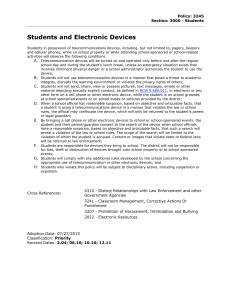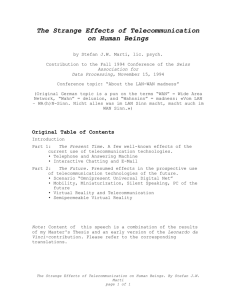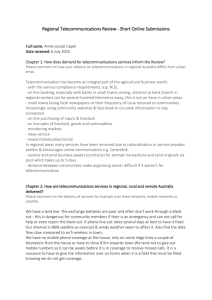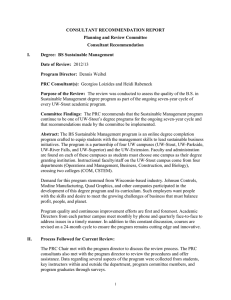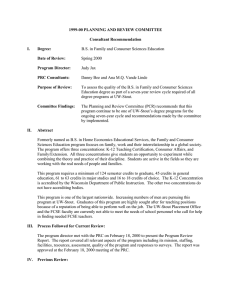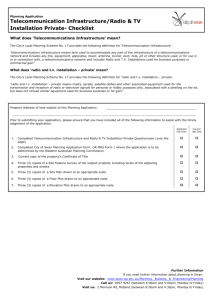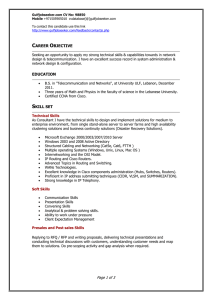2000 - 2001 Planning and Review Committee Consultant Report I.
advertisement
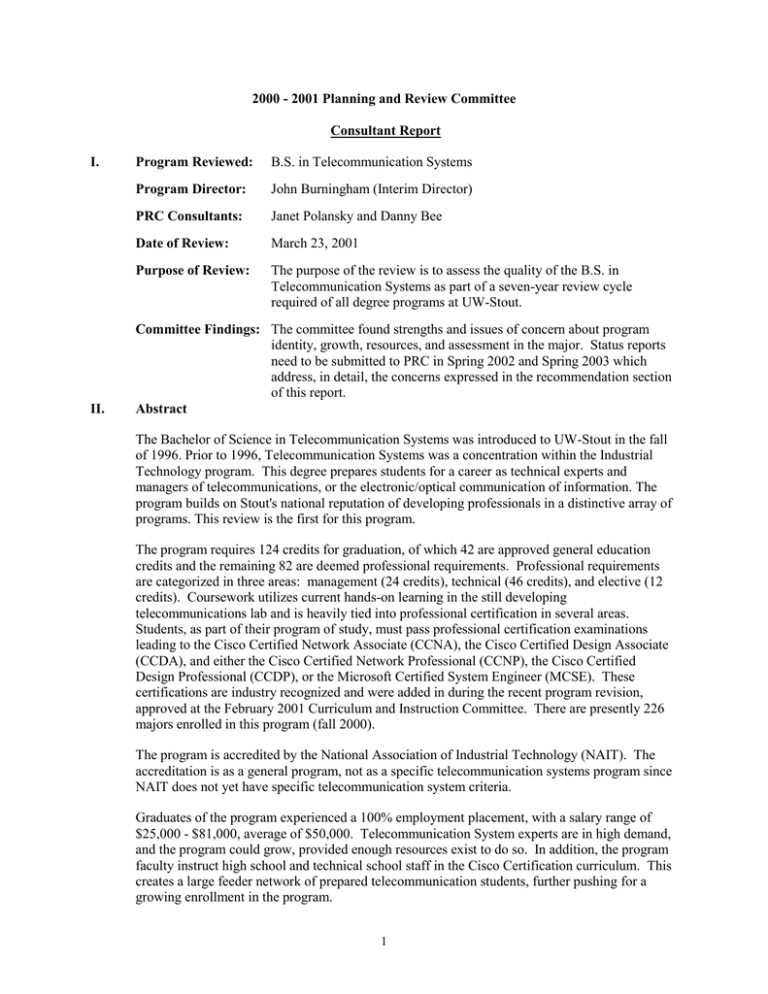
2000 - 2001 Planning and Review Committee Consultant Report I. II. Program Reviewed: B.S. in Telecommunication Systems Program Director: John Burningham (Interim Director) PRC Consultants: Janet Polansky and Danny Bee Date of Review: March 23, 2001 Purpose of Review: The purpose of the review is to assess the quality of the B.S. in Telecommunication Systems as part of a seven-year review cycle required of all degree programs at UW-Stout. Committee Findings: The committee found strengths and issues of concern about program identity, growth, resources, and assessment in the major. Status reports need to be submitted to PRC in Spring 2002 and Spring 2003 which address, in detail, the concerns expressed in the recommendation section of this report. Abstract The Bachelor of Science in Telecommunication Systems was introduced to UW-Stout in the fall of 1996. Prior to 1996, Telecommunication Systems was a concentration within the Industrial Technology program. This degree prepares students for a career as technical experts and managers of telecommunications, or the electronic/optical communication of information. The program builds on Stout's national reputation of developing professionals in a distinctive array of programs. This review is the first for this program. The program requires 124 credits for graduation, of which 42 are approved general education credits and the remaining 82 are deemed professional requirements. Professional requirements are categorized in three areas: management (24 credits), technical (46 credits), and elective (12 credits). Coursework utilizes current hands-on learning in the still developing telecommunications lab and is heavily tied into professional certification in several areas. Students, as part of their program of study, must pass professional certification examinations leading to the Cisco Certified Network Associate (CCNA), the Cisco Certified Design Associate (CCDA), and either the Cisco Certified Network Professional (CCNP), the Cisco Certified Design Professional (CCDP), or the Microsoft Certified System Engineer (MCSE). These certifications are industry recognized and were added in during the recent program revision, approved at the February 2001 Curriculum and Instruction Committee. There are presently 226 majors enrolled in this program (fall 2000). The program is accredited by the National Association of Industrial Technology (NAIT). The accreditation is as a general program, not as a specific telecommunication systems program since NAIT does not yet have specific telecommunication system criteria. Graduates of the program experienced a 100% employment placement, with a salary range of $25,000 - $81,000, average of $50,000. Telecommunication System experts are in high demand, and the program could grow, provided enough resources exist to do so. In addition, the program faculty instruct high school and technical school staff in the Cisco Certification curriculum. This creates a large feeder network of prepared telecommunication students, further pushing for a growing enrollment in the program. 1 III. Process Followed for Current Review: In the fall of 2000 key instructors, students, and the program advisory committee survey results were obtained and provided to the PRC consultants. The interim program director has discussed the report with the PRC consultants. An initial self-study report was made available to the consultants on February 23, 2001. Consultant concerns with the program resulted in a delay of the initial PRC presentation and a resubmission of the self-study report on March 13, 2001. The final self-study report was made available to the PRC committee before the March 23, 2001 presentation to that committee. IV. Previous Review This is the first review of the program. V. Current Program Review Program Strengths Data from the surveys, program self-study report and discussions with the program director support the following conclusions: 1. The program is felt to be on the leading edge of a rapidly changing professional field, offering technical depth in telecommunication systems and in managerial emphasis. 2. Fit between the program and industry demands is good. Students are receiving exceptional job offers directly out of this program. In addition students with excellent experience are often enticed by industry prior to the completion of the degree. Graduates have experienced 100% placement with strong demand beyond the number of graduates of the program 3. Most faculty have current industry experience. 4. Support from industry is evident in the development of the Telecommunications Lab in 213 Fryklund Hall. 5. The new Telecommunication Systems Lab provides access for students to develop, apply and research contemporary strategies involving, voice, data, and video technologies. 2 Issues of Concern Issue Source 1. Program perceived to be Cisco certification program, not Telecommunication Systems program. 2. Lab activities are not available for students. In addition, there seems to be a student perception that lab instruction is not of the quality it should be. 3. Lack of understanding of mission/vision of the program. Students do not understand new curriculum and telecommunications faculty do not agree on direction of program. 4. Program size may be larger than the telecommunications faculty staff can handle. 5. Additional equipment is needed to support program. 6. Lack of a capital equipment plan for the Telecommunication Systems Lab. 7. Classroom course scheduling problems exist. 8. Structured lab activities not developed in some areas due to lack of lab equipment. Student surveys Student surveys Key Instructor Surveys, Student Surveys Program Self-Study Report Student Surveys, Program SelfStudy Report Program Self-Study Report Program Self-Study Report Program Self-Study Report, Student Surveys Committee Recommendations 1. In the Spring of 2002, the program director and dean need to provide a status report that addresses the following: a. concerns noted about program size and staffing; b. include a detailed plan for managing enrollment growth in a way that enhances quality without sacrificing access.; c. program should demonstrate that it has a plan and has begun collecting data for assessment in the major; and d. university needs a campus-wide examination of program growth and enrollment issues. 2. In the Spring of 2003, the program director and dean need to provide a status report that addresses the following: a. concerns noted about lab equipment and activities; and b. concerns about program mission and identity. 3
